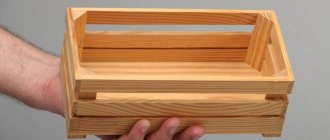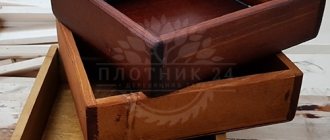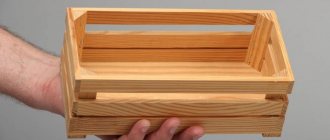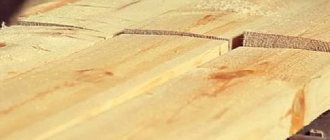If the master’s tools are in order, then the work moves quickly and easily. No need to look for where the bolts, pliers or hammer are, everything is at hand. Factory-made organizers offer ready-made storage solutions, but they are not always convenient, and the cost of high-quality models is not the cheapest. If you have the desire and leftover materials after repairs, making a tool box with your own hands will not be difficult, and it will cost much less than the factory equivalent.
Varieties and materials
There are many types of organizers:
- The simplest designs where all the tools and small accessories available in the house are stored. If the work is performed periodically, this is a completely convenient option.
- For storing a certain tool, for example, an angle grinder or a drill, especially if the device is not included in the factory configuration.
- Spacious and versatile, with numerous compartments and even wheels for easy movement.
- With advanced features, including workplace organization. For example, the structure unfolds and transforms into a small table with equipment attached to its surface.
Each craftsman can make a tool box “for himself”. If you don’t have to do repairs too often, then limit yourself to a simple drawer with a handle. It is advisable to provide several compartments or external “pockets” in which all the necessary items would be placed.
When there is a lot of equipment and you have to use it regularly, you will need a professional organizer. The location of compartments, cells or containers in this case must be carefully thought out in order to quickly find what you need.
When making a tool box organizer, the following are used:
- Metal - sheet aluminum, stainless steel, galvanized steel. Structures made from them are resistant to mechanical stress and corrosion, reliable, and durable.
- Wood - plywood, chipboard, fiberboard, MDF, bars, boards. The material is easy to process; you can use any scraps remaining from the repair.
- Plastic - for storing and carrying heavy tools, it is better to use impact-resistant polypropylene. It is not as fragile as other types of polymers, can withstand fairly high loads and is not afraid of frost. To keep small items of light weight in order, you can use any sheet of plastic.
Devices are often made in combination - a body made of durable metal or plywood, plastic filling, fiberboard. Small containers, containers, and cuttings of polymer pipes are suitable for small items.
To make materials last longer, you need to use protective equipment. Wooden parts are painted or impregnated with linseed oil. Aluminum, stainless steel, galvanized steel or plastic are themselves resistant to moisture and corrosion, so they do not require additional processing.
Material selection
Products made from different types of materials are on sale - from fabric to plastic and metal. All varieties are created taking into account high wear resistance, but different load levels can be provided. The weight of the finished product is also important; it should allow comfortable transportation. It is better to choose compact devices weighing no more than 1 kg, but as the size increases, the weight increases proportionally.
Small bags are most often made from nylon. This fabric can withstand significant loads without damage and easily withstands various weather conditions. Nylon does not get wet and is not subject to abrasion.
Tool storage bag Source iron-harry.ua
Large containers are made of aluminum or metal-plastic, which has a positive effect on their strength. There are also steel and wooden models, but purchasing them is not always convenient. Such products look beautiful, but are heavier and more difficult to maintain; such characteristics reduce ease of use.
Design
For manual production, you can limit yourself to a simple design or “swing” at a more complex option. This will depend on the functions assigned to the organizer, as well as on the type of stored devices and materials:
- A simple box with a handle is often used for carpentry, construction or painting tools. It is easy to make, quite versatile and easy to carry.
- Case - a suitcase-type design, closed with a lid with a lock. In such an organizer you can keep small tools, fragile devices, and consumables.
- A container with a lid is a very popular option. The internal space is organized according to the needs of the user. Large tools are placed on the bottom, and containers for storing “small things” are installed on top. They can be either fixed or removable.
- Folding accordions. When folded they are very compact, and when unfolded they provide a complete overview of everything that is inside.
- With retractable compartments - they are a cabinet-type structure. Each compartment is separate, all items are neatly folded and do not come into contact with each other.
- On wheels - a convenient modification of any heavy organizer. The problem of carrying it over long distances disappears by itself. For professional craftsmen or teams performing a wide range of work, this is a significant help.
- A box stool is a functional option that can be used as a seating area or a small work surface.
What are they and how to choose?
The range of tool boxes is huge. Depending on the material of manufacture, purpose and design features, they are conventionally divided into several groups.
Closed or open type
An open box or tray without a lid is good for storing a minimum set of tools that should always be at hand. Open boxes, as a rule, are not large in size and are easy to move from place to place.
But the absence of a lid means that the contents of the box become covered with dust over time, and if handled carelessly, the contents of the box can easily spill out.
Closed boxes are equipped with a lid with a lock. This option is preferred by craftsmen - professionals who constantly carry the tool with them to different objects.
Various in design
The most popular option is a box, with a removable lid and handle . It has a large capacity, allowing you to store all the necessary tools in one place.
A small suitcase, the interior of which is divided into many sections - a case. This box is very convenient for moving things needed for repairs. A small box with pull-out sections—an organizer—is suitable for storing small tools, as well as fasteners.
An open container without a lid - a tray - is good because all the tools collected in it are in plain sight. Unfortunately, trays are not always equipped with handles, which creates some difficulties in moving the box. A dolly is a large box on wheels designed to store and move heavy tools.
According to the material of manufacture
Boxes can be made of wood (pine or hardwood is most often used). Wooden boxes are quite light .
In order for the box to last as long as possible, the wood must be treated with protective varnishes or paints.
Metal tool organizers are most often made of steel or aluminum. Products must be painted or galvanized. Metal boxes are reliable (withstand impacts) and durable . The only disadvantage of metal products is their high cost.
A plastic box is the best option, combining affordable cost, light weight, and durability. Most often, high-quality polypropylene is used for production. This material is resistant to temperature changes and mechanical damage.
High quality practical tool box:
- It features a durable bottom and rigid walls (particular attention is paid to the adhesive seams between the bottom and the walls).
- It has a large number of different sections (each type of instrument has its own option).
- Closes tightly (the locks must work clearly, open without effort, and secure the lid tightly when closing).
- Made from durable, high quality materials.
When purchasing a tool box, it is a good idea to inquire about the quality certificate for the selected product.
Operating principles and manufacturing requirements
Craftsmen quite often encounter the breakdown of a purchased organizer. Flimsy structures cannot withstand loads, accidental impacts, crack and become unusable.
The weak point of factory boxes is the handles and locks. As a rule, in inexpensive models they are made of plastic or very thin metal, which quickly fail under heavy operating conditions.
All these nuances can be provided for in a DIY toolbox. Durable material, reliable fastenings, and high-quality fittings will ensure not only comfortable use, but also an unlimited service life.
The organizer manufacturing process includes:
- development of a design drawing;
- preparation of materials;
- cutting parts to size;
- assembly;
- installation of accessories;
- protective and decorative treatment.
When preparing the drawing, the type of storage, the dimensions of the tool, the number of compartments, the method of opening and carrying are taken into account.
Working drawing with dimensions
Metal tool box
The metal is highly durable and durable, but working with it requires skill, as well as special processing tools.
Required:
- sheet of galvanized sheet or aluminum;
- metal scissors;
- riveter;
- handles, locks, hinges.
Most often, case structures or folding “accordions” are made from metal, where the ribs form a rigid frame. In this case, a sufficiently thin sheet does not deform under load.
Step-by-step production of a metal tool box:
- On the sheet mark the main elements of the organizer - side parts, bottom, lid, taking into account an allowance of 1-1.5 cm for connection.
- Cut out the elements using metal scissors.
- Fold in the seam allowances along the edges.
- Rivet the joints with a riveter.
- Connect the compartments together using strips or special springs.
- Install locks and handle.
If there is no riveter, you can connect the parts with bolts, nuts and washers. This is a more labor-intensive job, but is also used on thin-sheet structures. The fasteners are chosen to be stainless or galvanized so that when paired with the metal of the organizer, it does not quickly begin to corrode.
Plastic tool box
A modern plastic L-boxx can be made from foamed PVC or any other polymer sheet material with sufficient mechanical strength. You will need glue for the plastic and transparent plastic for the lid.
Making a plastic tool box is easy. The parts are cut out with a regular knife, the joints are glued, and cured until they gain strength.
The top of the device is closed with a transparent lid, through which all the contents are visible. Drills, screws, nuts, soldering supplies - everything will be in separate compartments in plain sight.
The procedure for making a plastic box:
- Mark the contours of the bottom, walls and partitions on the sheet.
- Cut out the elements with a knife.
- Carefully glue the parts together.
- Make a lid.
- Clean the edges with fine sandpaper.
Such a box is not intended for storing heavy equipment, but it is quite useful for organizing all the “little things” necessary for work.
Wooden tool box
The simplest and most affordable option is to make a tool box from plywood or thin planed boards. Surely there are scraps of suitable sizes in the house. Cutting and drilling wood materials is not difficult, so even a beginner can handle the job. You will need a jigsaw or hacksaw, a screwdriver, and wood fasteners.
Part connections can be made in various ways:
- half a tree;
- dovetail;
- with dowels;
- with tongues and grooves;
- on self-tapping screws.
To neatly connect the boards into half a tree, select half the thickness of the element on each of them. The parts are glued together at the sampling site. If you choose the dovetail method, you need to file a trapezoidal cutout at one end, and a protrusion of a similar shape at the other.
To connect dowels, blind holes are drilled in two adjacent structures, glue is applied around them, then dowels - pieces of wooden rod - are inserted. When tightly joined, the structures are held together. The joint with tongues and grooves is labor-intensive and requires precise cutting of parts in the form of a toothed comb at the joint.
Joints between wooden structures are strengthened by gluing. To perform this operation correctly, you need:
- Carefully sand the joint area.
- Remove dust and degrease.
- Apply glue to both surfaces.
- Let the composition stand for some time (the duration is indicated in the instructions).
- Press the elements together and secure with a clamp.
- Remove excess glue and leave until the composition is completely polymerized for about a day.
It is recommended to load the adhesive joint no earlier than after 24 hours. The junction is neat and invisible. If the toolbox does not have any decorative requirements, it is easier and faster to fasten the elements with ordinary self-tapping screws. Pre-drilling of holes is not required.
Instructions and steps for making a tool box
A step-by-step analysis of the manufacture of basic versions of boxes will help you create your own unique project. In each of the options, you can add additional compartments, use existing materials instead of those specified, and also make any other changes within the design.
The simplest portable box
The simplest portable box was invented back in the Soviet era. It is quite simple to make. There are no compartments for fasteners, but you can make them yourself. The box itself is an open box with a triangular top and crossbar.
There is a tray in the upper part of the structure for small items. There are two mounting options for the box. The parts can be glued on or self-tapping screws can be used. Any board can be used as material. The handle of a shovel or other metal or wooden piece with a round cross-section will fit under the handle. The main thing is that the future box is comfortable to hold in your hand.
Drawing of a simple portable box
You can use thick plywood instead of boards. All parts need to be cut out; it is advisable to sand the edges with coarse sandpaper. Then, by driving self-tapping screws at the intersection of the parts, fasten all the elements. There is nothing complicated about this; the full cycle of making a box will take less than 2 hours. After the organizer is ready, it is advisable to cover it with paint or varnish. Inside, you can make a division using additional partitions, dividing the box into sections.
For small items, you can make a separate section, or you can attach a tray to the top of the drawer. The tray is an open rectangular gutter, which is also attached with self-tapping screws.
Tool box on wheels
A toolbox on wheels is a more complex storage system. It can be used to hide heavy power tools. At the same time, the organizer can also accommodate fasteners with the rest of the set of small and medium-sized tools.
Before making a box, you need to estimate the dimensions of the project. First of all, decide on the number of boxes. Keep in mind that you cannot put more than 1-2 electric tools in one drawer. Taking into account the dimensions of the drill or hammer drill, you need to select the depth of the boxes. It is possible to provide open shelves for a welding machine and other large equipment.
Another point that you need to decide is the number of drawers in width. As a rule, the design has only one drawer in width, so it is easier to assemble all the elements together. Only the number of drawers in length and their depth change. After assembling the parts, each box is divided into separate storage areas. But if there are too many tools, then the organizer may turn out to be too high, which is very inconvenient. Therefore, for such storage places it is possible to provide a width of two drawers, but between them an additional frame of metal corners is required as a stiffener. It is advisable to make handles on top in the form of curved metal pipes or welded corners. Handles are necessary for easy movement of the organizer.
The material you will need are metal corners as the basis of the structure and plywood as filler. Boards will also work, but they will take up a lot of usable space.
Once the number of drawers has been determined, you can calculate the length and width of the future organizer. The corners are fastened together by welding. The seam should be neat, on the outside of the box. The scale must be knocked off with a hammer. Once the frame is ready, you can immediately weld wheels onto it for moving.
If the organizer is more than 1 drawer wide, you will need more than 4 wheels: 6 or 8 for 2 and 3 drawers, respectively.
The boxes are assembled separately on the floor, after which fasteners from the corners are welded under them, where the boxes are installed. The boxes should be as large as possible; division into sections is done later, immediately across the entire depth of the box using pieces of plywood. You can make your own compartment for each type of tools and fasteners. It all depends only on the preferences of the future owner.
Metal box for tools
The metal box for tools has a long service life and is convenient for long-distance transportation. To make a box you will need a caliper and a tape measure for measurements, welding and a sheet of metal. It is advisable to use as little welding as possible; most of the bending should be done using an anvil and hammer.
First you need to estimate the required volume of the box, put the parts on the sheet and cut along the lines. After this, bend the box and weld the necessary seams. The handle is attached to the drawer with bolts. The resulting design will be in many ways similar to the first wooden version. In order to create additional space for storing tools, you need to attach guides to the bottom for a metal box, which can also be made by welding.
You can make several boxes, securing them with rivets, as shown in the figure. This will make the box more compact and practical. Allows you to store a large number of necessary small items and tools.
Metal box for tools
How to make an open box: step-by-step instructions with drawings, dimensions and photos
The simplest tool organizer is a box-shaped design with a handle. You can arrange several compartments inside, and attach “pockets” of various capacities to the outside.
For a medium sized box you will need:
- plywood, board, MDF or other wood sheet material that can be easily fastened with self-tapping screws;
- fasteners;
- electric jigsaw;
- screwdriver;
- pencil, ruler;
- linseed oil for wood processing.
Mark the details:
- A - bottom of the box 35x20 cm;
- B - 2 side parts 22x22 cm;
- C - 2 long side elements 35x10 cm.
A handle 35 cm long is prepared from the block with a small margin. Then you can adjust the dimensions accordingly. You can use steel or aluminum tubes, scraps of smooth fittings.
Cut out the marked parts with a jigsaw. The bottom and sides are alternately connected using self-tapping screws, which are screwed through the part into the end of the other element. The approximate step for installing hardware is 7-10 cm. You can additionally glue all joints with wood glue.
To avoid misalignment during fastening or hardware breakage, self-tapping screws must be installed correctly:
- do not screw into places with knots and other wood defects;
- install fasteners perpendicular to the surface;
- the axes of the screwdriver and the self-tapping screw must strictly coincide;
- increase the twisting speed smoothly, without jerking.
Some craftsmen recommend pre-rubbing the screws with soap. After this they enter the wood very easily.
The handle block is sanded until smooth. When attaching it to the sidewalls, you first need to drill a hole through the part, and then screw in the self-tapping screw.
The handle can be made folding - cut holes in the sides, thread a strong cord and tie a block to it. The box is carried in the usual way, then the handle is placed to the side. In this form, it does not interfere with access to tools.
For small parts, side pockets are made of plywood or fiberboard. The plates are cut out to appropriate sizes and screwed to the sidewalls through narrow linings.
Partitions are cut out for internal compartments. They are secured using overlays or inserted into pre-cut grooves.
Under the containers to be removed, stops made of bars or scraps of plywood are installed inside the box. You can make removable containers yourself from sheet plastic, tin, wood, or take ready-made ones of a suitable size.
After assembly, the organizer is coated with linseed oil. You can paint the wood with acrylic varnish for external work or treat it with stain or antiseptic impregnation.
Stool box: drawings and description
This is a carpentry product of a more complex level of manufacture than a simple box. For a stool on which you can sit or stand, a durable frame is built from a bar. The interior space is used to store tools.
You will need:
- board 20 mm thick;
- block 50x50;
- plywood 8-10 mm;
- wood glue;
- cutting tool;
- screwdriver or drill;
- block, fine sandpaper or sander;
- hinges, handles, lock.
First prepare a drawing with dimensions
Now you need to assemble the stool:
- Trim the blanks to size.
- Connect the bars with tongue-and-groove fastenings and dowels.
- Cut out the bottom and sides from plywood.
- Sand all the details.
- Lubricate the contacting surfaces with glue.
- Insert dowels and connect the elements, remove excess lei
- Tighten with clamps for 24 hours.
Aging in clamps
While the glue is setting, a seat is made from the board. The parts are polished and the edges are rounded. Glued to the frame and connected with an “oblique” screw.
The sides and bottom are fixed to the stool. The opening part is secured with overhead hinges. To prevent the lid from opening spontaneously, install a latch. The functional box-stool is ready.
Plywood tool storage box with lid
The lid design is very practical. Tools become less dirty and are not subject to accidental exposure to snow or rain outdoors.
The lid can be hinged or removable. If the handle is attached directly to it, the hinge and lock mechanisms must be as reliable as possible. The entire load will be taken by these parts; how long the organizer will last depends on their quality.
Before starting work, you need to prepare a drawing of a tool box, where you indicate the dimensions and numbering of parts. Such a simple operation will help during assembly, you will quickly find them and dock them correctly.
For an organizer with a lid you will need:
- plywood 12-18 mm thick for the frame, 6-10 for non-load-bearing parts;
- self-tapping screws;
- wood glue;
- overhead hinges (mortise, hinged or other type as desired);
- a pen (buy ready-made in a store or take from an old suitcase);
- ruler, pencil;
- hacksaw or jigsaw;
- screwdriver;
- clamps;
- a block for sanding edges.
Step by step execution:
- Transfer the markings from the drawing to the plywood and number them.
- Use a jigsaw or hacksaw to prepare the parts.
- Using glue and self-tapping screws, assemble the body. Tighten the structure with clamps until it dries completely.
- In a similar way, make internal removable trays.
- Secure the bars for stops parallel to each other in the box.
- Assemble the cover and secure it to the body with hinges.
- Install locks.
- Attach the handle to the lid.
- Sand and treat with a protective and decorative agent.
After installing the removable containers, the organizer is ready for use. This box is not only durable and convenient, but also looks quite solid.
How to do it yourself?
The tool organizers presented in stores do not always correspond to the desired sizes and contents. For those who have not found a suitable drawer, the solution to the problem will be to make an organizer with your own hands. Let's look at an example of how to assemble a wooden tool box with a lid.
Preparatory stage
To work you will need:
pine board (inexpensive, easy-to-process material);- wood glue;
- metal corners (8 pcs.);
- self-tapping screws;
- furniture hinges (2 pcs.);
- lock - latch (2 pcs.);
- hacksaw, drill, clamp;
- sandpaper.
Then, according to the drawing below, the elements of the future organizer are cut out of the boards using a hacksaw.
Assembly
The box body and lid are assembled first. The necessary elements, the edges of which are pre-coated with wood glue, are connected and fixed with self-tapping screws. The removable tray is assembled in the same way. To make it convenient to remove it from a large box, a handle is fixed at the top. The third element is the lid.
After all the elements have been assembled, the wood must be thoroughly sanded and coated with a protective varnish or stain.
The final stage of assembly is the installation of furniture hinges (connecting the lid to the box) and latches - locks. Additionally, the corners of the organizer are decorated with metal protective corners, and a handle is fixed to the lid. Your DIY tool box is ready!
The video will show you how to make a tool box with your own hands:
Portable box with drawer
This is almost a mini-version of a workshop. The top panel can be used to work with various equipment; inside is an excellent place to store tools, accessories and consumables. If you put the organizer on wheels, you get a mobile Toolbox.
The interior of the box has a compartment for large tools and pull-out compartments for small items. Additionally, you can install a panel for rulers, screwdrivers, knives, etc.
The structure is made of plywood, connecting the parts with glue and self-tapping screws. For strength, you can fasten the organizer with stiffening ribs from a 50x50 mm bar.
There is nothing complicated about assembling the box itself. The drawer design requires the most attention. It is expected to be loaded, so if it is not positioned correctly it can bind when moving and slip out of its mounts.
To install a retractable compartment, you will need guides, which can be roller or ball. The sliding of the runner occurs due to the torsion of the rollers in the grooves or the movement of the guide parts themselves relative to each other in special tracks.
Roller mechanisms are inexpensive, but less reliable. Ball ones are stronger and more durable, they move silently and allow you to open the drawer all the way. You can use reinforced versions of products that can withstand heavy loads.
To install a drawer, mark the fastening line of the guide on the wall, and the mating part on the side element of the compartment. Here it is important not to make a mistake and to connect the structures correctly in height so that the box fits tightly, but there is a small gap left for free movement. Even the slightest misalignment between parallel sides should not be allowed.
Assembly sequence:
- Cut out parts from plywood and sand.
- Assemble the frame and box using self-tapping screws and glue.
- Let it stand until it gains strength.
- Mark the guide lines on the internal side posts and sides of the drawer.
- Secure the runners with self-tapping screws.
- Insert the compartment until it clicks, slightly lifting the edge. After this, the box should move freely along the guides.
- Arrange the organizer space as you wish.
- Attach carrying handles.
- Carry out final protective and decorative treatment.
If desired, you can make several drawers of the same or different sizes. This will allow you to make maximum use of the organizer’s space.
Option with shoulder strap
Tool Chest Ideas
In the hands of a true craftsman, any thing that has outlived its useful life can become a useful and functional device. Various ideas that are implemented from improvised means arouse interest and become an impetus for one’s own creativity:
- A tool box made from cable ducts and sofa springs is an economical lightweight device for storing small accessories.
- Plastic canisters are record holders for generating various ideas. If you cut out a window in the upper part, such a container can be used to store screws, nails, drills and anything else that may be useful in your work.
- A shopping cart, if obtained legally, can be transformed into a convenient Tool-box through some transformations. It is enough to arrange compartments or shelves, and the handle and wheels are already there.
- Old "diplomacy" bags are strong and durable, and reliable locks have worked properly for more than 20 years. Inside the case you can arrange small pockets for storing small items, and the suitcase itself can easily withstand the weight of a drill or screwdriver.











